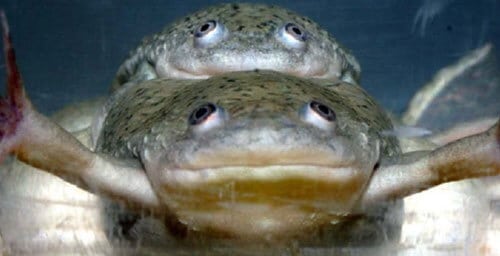An international team of researchers has reviewed the evidence linking exposure to atrazine – an herbicide widely used in the U.S. and more than 60 other nations – to reproductive problems in animals. The team found consistent patterns of reproductive dysfunction in amphibians, fish, reptiles and mammals exposed to the chemical.
Atrazine is the second-most widely used herbicide in the U.S. More than 75 million pounds of it are applied to corn and other crops, and it is the most commonly detected pesticide contaminant of groundwater, surface water and rain in the U.S.
The new review, compiled by 22 scientists studying atrazine in North and South America, Europe and Japan, appears in the Journal of Steroid Biochemistry and Molecular Biology.
The researchers looked at studies linking atrazine exposure to abnormal androgen (male hormone) levels in fish, amphibians, reptiles and mammals and studies that found a common association between exposure to the herbicide and the “feminization” of male gonads in many animals.
The most robust findings are in amphibians, said University of Illinois comparative biosciences professor Val Beasley, a co-author of the review. At least 10 studies found that exposure to atrazine feminizes male frogs, sometimes to the point of sex reversal, he said.
Beasley’s lab was one of the first to find that male frogs exposed to atrazine in the wild were more likely to have both male and female gonadal tissue than frogs living in an atrazine-free environment. And in a 2010 study, Tyrone Hayes, a professor of integrative biology at the University of California at Berkeley and lead author of the review, reported in the Proceedings of the National Academy of Sciences that atrazine exposure in frogs was associated with “genetic males becoming females and functioning as females,” Beasley said.
“And this is not at extremely high concentrations,” he said. “These are at concentrations that are found in the environment.”
The new review describes the disruptions of hormone function and sexual development reported in studies of mammals, frogs, fish, reptiles and human cells exposed to the herbicide. The studies found that atrazine exposure can change the expression of genes involved in hormone signaling, interfere with metamorphosis, inhibit key enzymes that control estrogen and androgen production, skew the sex ratio of wild and laboratory animals (toward female) and otherwise disrupt the normal reproductive development and functioning of males and females.
“One of the things that became clear in writing this paper is that atrazine works through a number of different mechanisms,” Hayes said. “It’s been shown that it increases production of (the stress hormone) cortisol. It’s been shown that it inhibits key enzymes in steroid hormone production while increasing others. It’s been shown that it somehow prevents androgen from binding to its receptor.”
The review also consolidates the evidence that atrazine undermines immune function in a variety of animals, in part by increasing cortisol.
“Cortisol is a nonspecific response to chronic stress,” Beasley said. “But guess what? Wildlife in many of today’s habitats are stressed a great deal of the time. They’re stressed because they’re crowded into little remnant habitats. They’re stressed because there’s not enough oxygen in the water because there are not enough plants in the water (another consequence of herbicide use). They’re stressed because of other contaminants in the water. And the long-term release of cortisol causes them to be immuno-suppressed.”
There also are studies that show no effects – or different effects – in animals exposed to atrazine, Beasley said. “But the studies are not all the same. There are different species, different times of exposure, different stages of development and different strains within a species.” All in all, he said, the evidence that atrazine harms animals, particularly amphibians and other creatures that encounter it in the water, is compelling.
“I hope this will stimulate policymakers to look at the totality of the data and ask very broad questions,” Hayes said. “Do we want this stuff in our environment? Do we want – knowing what we know – our children to drink this stuff? I would think the answer would be no.”

If our reporting has informed or inspired you, please consider making a donation. Every contribution, no matter the size, empowers us to continue delivering accurate, engaging, and trustworthy science and medical news. Independent journalism requires time, effort, and resources—your support ensures we can keep uncovering the stories that matter most to you.
Join us in making knowledge accessible and impactful. Thank you for standing with us!

